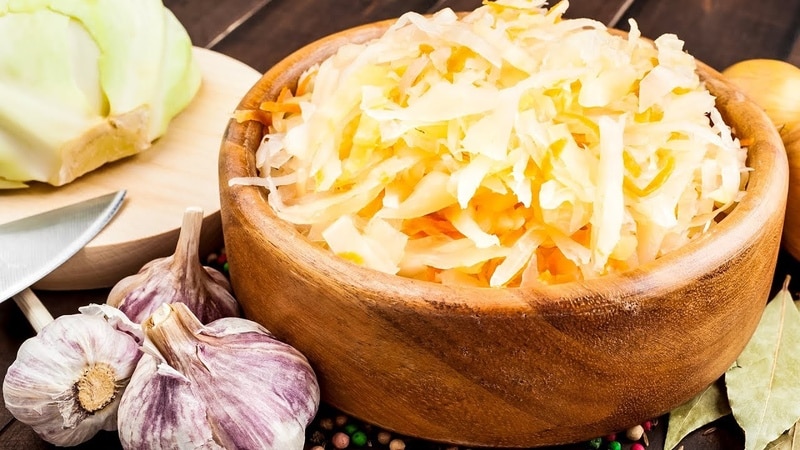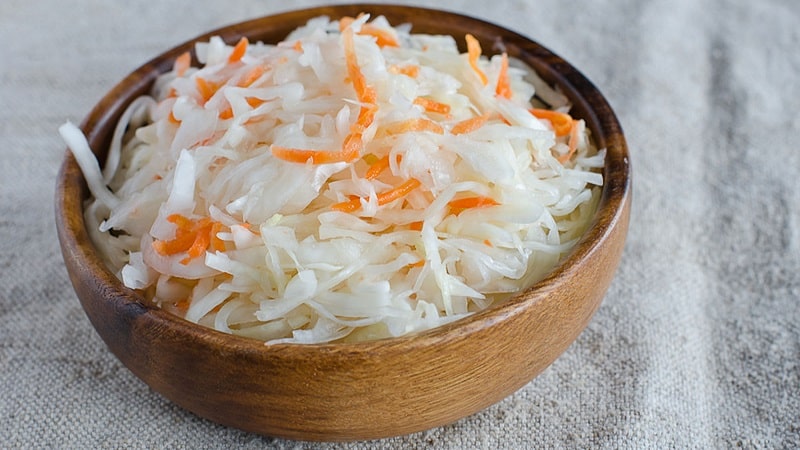What to do if cabbage does not ferment
Every year thousands of people make sauerkraut. But even experienced housewives do not always know the rules for preparing this dish. As a result, the vegetable does not ferment, acquires a rotten smell, or turns out soft and not crunchy - and all efforts are in vain.
In this article we will tell you why cabbage does not ferment when fermented and how to solve the problem if the cabbage is under-fermented.
Why doesn't cabbage ferment?

Fermentation is a chemical reaction during which lactic acid bacteria develop. It is thanks to them that the product is fermented. In order for bacteria to multiply, favorable conditions are created:
- optimal temperature is maintained in the room;
- use only clean jars;
- maintain proportions;
- Wash vegetables thoroughly before slicing.
If even one of the conditions is not met, the cabbage may not ferment.
Why does cabbage go rotten?
Housewives, especially beginners, often encounter the fact that the workpiece acquires a musty smell, darkens, becomes slippery and too sour. What could lead to such an unpleasant result?
There are different reasons:
- Not enough juice. You can’t put the cabbage in a jar immediately after shredding. Before this, it is crushed to release the juice.
- For salting, the wrong salt was used or the proportions were incorrect. For fermentation, use regular table salt without additives. Iodized water is not used for pickles.
- The vegetables in the jar “suffocated” under the influence of fermentation gases.During chemical reactions, carbon dioxide accumulates in the container. On the third day, they begin to pierce the contents of the jar with a wooden stick so that the gas comes out. Do this 2-3 times a day.
- Oxygen entering the jar. To prevent this from happening, the brine must completely cover the cabbage.
- The appearance of fungus. After salting on the 2nd or 3rd day, foam will form on the surface of the jar. It is important to remove it in time, otherwise fungus may appear and the pickles will no longer be edible.
How to save sauerkraut if it doesn't ferment
If the cabbage does not ferment, it means that a mistake was made during preparation. In some cases it can be fixed.
Fermentation should begin on the second day. If this does not happen, but the vegetable looks quite normal in appearance and there is no unpleasant odor, then the situation can still be saved.
What to do if the cabbage has not fermented:
- Dilute sugar in water at the rate of 2 tsp. for 1 kg of vegetable and add liquid to the jar.
- Check the temperature in the room where the cabbage is fermented. It shouldn't be too cold or too warm. The optimal temperature for fermentation is +17…+21°С.

What to do if you oversalt
There are two ways to make cabbage less salty.
Method 1
Add water. This can only be done at the very beginning of the ferment, when the juice has been released. First you need to taste the brine, because it contains the main amount of salt. If the brine is too salty, it is recommended to pour out about a third of the liquid and pour the same amount of regular, settled water into the jar.
When mixed, the concentration of salt in the jar will decrease and the necessary environment for fermentation will be formed.This method is only suitable if the workpiece was made in a small container - to mix the water with the brine, you need to shake the container. If cabbage is fermented in a barrel, this will be impossible to do.
Attention! You cannot drain all the brine, otherwise the cabbage will lose its taste and juiciness.
Method 2
Add an egg. This method is applicable when fermentation is over, but suddenly it turns out that the product tastes too salty. Take a raw chicken egg and break it into cheesecloth, and then place it in a jar for 10 minutes. During this time, the egg will absorb excess salt.
Important! Place the egg into the jar very carefully. If the egg leaks out of the gauze, the cabbage will become unfit for consumption.
How to ferment correctly
Sauerkraut is prepared through natural fermentation. It contains many vitamins and nutrients. High concentrations of vitamin C help improve immunity. To prevent the dish from losing its beneficial properties, pickling done according to traditional rules.
Choose the right variety
The selected variety of vegetable plays an important role in cooking. For pickling, only late varieties and hybrids of cabbage are used: for example, Moscow late, Geneva f1. These crops are harvested in early October. This type of cabbage has a slightly yellowish color, and when shredded, juice releases. The leaves are elastic, not too thick. Late varieties have a sweetish taste.
Maintain proportions
This is the most important rule. The amount of salt depends on the amount of vegetables. Yes, one head of cabbage weighs on average 3 kg. To ferment this amount of vegetable you will need 2.5 tbsp. l. salt.
If there is not enough salt, the vegetable will not begin to release juice. Accordingly, the fermentation process will not start.
If the proportions are observed, a lot of brine will be released.The containers must contain all the liquid, so choose containers taking into account subsequent fermentation.
Pickling technology

To make the cabbage tasty and juicy, follow these recommendations:
- Shred into pieces about 5 mm thick. If they are smaller, the cabbage will turn out soft.
- For pickling take regular, coarse, non-iodized salt.
- Fermentation is carried out in glass or wooden containers. You can also use enamel containers, provided that they are not chipped.
- Fermentation takes 3 days. After this deadline the dish can be eaten. However, the classic taste of sauerkraut will appear only a week after pickling.
- In order for the cabbage to ferment well, it is pressed down with a weight - a plate or a three-liter jar filled with water will do.
Store the finished dish at a temperature of 0…+2°C. For comfort storage in the refrigerator it is transferred into small glass jars.
Conclusion
Sauerkraut is a rather complicated process. It is important to maintain proportions, strictly follow the recipe and avoid mistakes during storage. Then the preparation will turn out tasty, juicy and crispy.
The anti-Putin people are fed up with their idiotic propaganda.